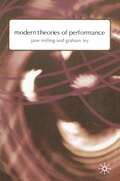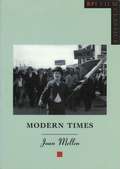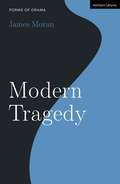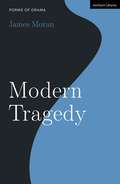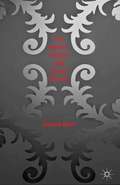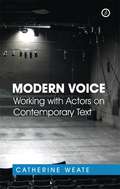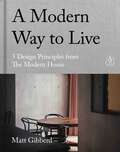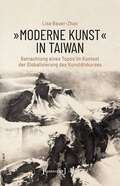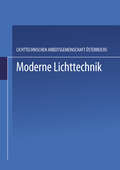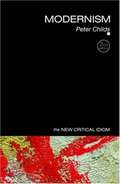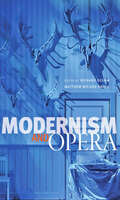- Table View
- List View
Modern Theories of Performance: From Stanislavski to Boal
by Jane Milling Graham LeyThe modern era in the theatre is remarkable for the extraordinary role and influence of theoretical practitioners, whose writings have shaped our sense of the possibilities and objectives of performance. This study offers a critical exploration of the theoretical writings of key modern practitioners from Stanlislavski to Boal. Designed to be read alongside primary source material, each chapter offers not only a summary and exposition of these theories, but a critical commentary on their composition as discourses. Close scrutiny of the cultural context and figurative language of these important, and sometimes difficult, texts yields fresh insight into the ideas of these practitioners.
Modern Times (BFI Film Classics)
by Joan MellenModern Times was Charlie Chaplin's last full-length silent film. The author situates 'Modern Times' within the context of Chaplin's life work, exploring its history and influences. She explores how the film's themes of oppression, industrialization and dehumanization are embodied in the little tramp's struggle to survive in the modern world.
Modern Times (BFI Film Classics)
by Joan MellenModern Times was Charlie Chaplin's last full-length silent film. The author situates 'Modern Times' within the context of Chaplin's life work, exploring its history and influences. She explores how the film's themes of oppression, industrialization and dehumanization are embodied in the little tramp's struggle to survive in the modern world.
Modern Tragedy (Forms of Drama)
by James MoranWhat distinguishes modern tragedy from other forms of drama? How does it relate to contemporary political and social conditions? To what ends have artists employed the tragic form in different locations during the 20th century? Partly motivated by the urgency of our current situation in an age of ecocidal crisis, Modern Tragedy encompasses a variety of drama from throughout the 20th century. James Moran begins this book with John Millington Synge's Riders to the Sea (1904), which shows how environmental awareness might be expressed through tragic drama. Moran also looks at Brecht's reworking of Synge's drama in the 1937 play Señora Carrar's Rifles, and situates Brecht's script in the light of the theatre practitioner's broader ideas about tragedy. Brecht's tragic thinking – informed by Hegel and Marx – is contrasted with the Schopenhauerian approach of Samuel Beckett. The volume goes on to examine theatre makers whose ideas were partly motivated by applying an understanding of the tragic narrative of Synge's Riders to the Sea to postcolonial contexts. Looking at Derek Walcott's The Sea at Dauphin (1954), and J.P. Clark's The Goat (1961), Modern Tragedy explores how tragedy, a form that is often associated with regressive assumptions about hegemony, might be rethought, and how aspects of the tragic may coincide with the experiences and concerns of authors and audiences of colour.
Modern Tragedy (Forms of Drama)
by James MoranWhat distinguishes modern tragedy from other forms of drama? How does it relate to contemporary political and social conditions? To what ends have artists employed the tragic form in different locations during the 20th century? Partly motivated by the urgency of our current situation in an age of ecocidal crisis, Modern Tragedy encompasses a variety of drama from throughout the 20th century. James Moran begins this book with John Millington Synge's Riders to the Sea (1904), which shows how environmental awareness might be expressed through tragic drama. Moran also looks at Brecht's reworking of Synge's drama in the 1937 play Señora Carrar's Rifles, and situates Brecht's script in the light of the theatre practitioner's broader ideas about tragedy. Brecht's tragic thinking – informed by Hegel and Marx – is contrasted with the Schopenhauerian approach of Samuel Beckett. The volume goes on to examine theatre makers whose ideas were partly motivated by applying an understanding of the tragic narrative of Synge's Riders to the Sea to postcolonial contexts. Looking at Derek Walcott's The Sea at Dauphin (1954), and J.P. Clark's The Goat (1961), Modern Tragedy explores how tragedy, a form that is often associated with regressive assumptions about hegemony, might be rethought, and how aspects of the tragic may coincide with the experiences and concerns of authors and audiences of colour.
The Modern Vampire and Human Identity
by Deborah MutchVampires are back - and this time they want to be us, not drain us. This collection considers the recent phenomena of Twilight and True Blood, as well as authors such as Kim Newman and Matt Haig, films such as The Breed and Interview with the Vampire, and television programmes such as Being Human and Buffy the Vampire Slayer.
The Modern Venus: Dress, Underwear and Accessories in the late 18th-Century Atlantic World
by Elisabeth GernerdFrom rumps and stays to muffs and handkerchiefs, underwear and accessories were critical components of the 18th-century woman's wardrobe. They not only created her shape, but expressed her character, sociability, fashionability, and even political allegiances. These so-called ephemeral flights of fashion were not peripheral and supplementary, but highly charged artefacts, acting as cultural currency in contemporary society. The Modern Venus highlights the significance of these elements of a woman's wardrobe in 1770s and 1780s Britain and the Atlantic World, and shows how they played their part in transforming fashionable dress when this was expanding to new heights and volumes. Dissecting the female silhouette into regions of the body and types of dress and shifting away from a broad-sweeping stylistic evolution, this book explores these potent players within the woman's armoury. Marrying material, archival and visual approaches to dress history, and drawing on a rich range of sources – including painted portraiture, satirical prints, diaries, memoirs – The Modern Venus unpacks dress as a medium and mediator in women's lives. It demonstrates the importance of these overlooked garments in defining not just a woman's silhouette, but also her social and cultural situation, and thereby shapes our understanding of late 18th-century life. With over 125 color images, The Modern Venus is a remarkable resource for scholars, students and costume lovers alike.
The Modern Venus: Dress, Underwear and Accessories in the late 18th-Century Atlantic World
by Elisabeth GernerdFrom rumps and stays to muffs and handkerchiefs, underwear and accessories were critical components of the 18th-century woman's wardrobe. They not only created her shape, but expressed her character, sociability, fashionability, and even political allegiances. These so-called ephemeral flights of fashion were not peripheral and supplementary, but highly charged artefacts, acting as cultural currency in contemporary society. The Modern Venus highlights the significance of these elements of a woman's wardrobe in 1770s and 1780s Britain and the Atlantic World, and shows how they played their part in transforming fashionable dress when this was expanding to new heights and volumes. Dissecting the female silhouette into regions of the body and types of dress and shifting away from a broad-sweeping stylistic evolution, this book explores these potent players within the woman's armoury. Marrying material, archival and visual approaches to dress history, and drawing on a rich range of sources – including painted portraiture, satirical prints, diaries, memoirs – The Modern Venus unpacks dress as a medium and mediator in women's lives. It demonstrates the importance of these overlooked garments in defining not just a woman's silhouette, but also her social and cultural situation, and thereby shapes our understanding of late 18th-century life. With over 125 color images, The Modern Venus is a remarkable resource for scholars, students and costume lovers alike.
Modern Voice: Working with Actors on Contemporary Text
by Catherine WeateModern Voice: Working with Actors on Contemporary Text has been designed to follow on from Catherine’s previous book, Classic Voice: Working with Actors on Vocal Style, focusing on the less defined demands within contemporary drama. Lifting contemporary speech rhythms off the page can be a challenge for actors. Sometimes these rhythms are realistic, resembling or mirroring the speech patterns of real human beings, sometimes they are non-realistic, distorting speech patterns for particular effect. Modern Voice not only provides an accessible approach for understanding speech rhythm but also presents an overview of different types and styles of contemporary text (including the rise of dramatic realism in England, America and Australia). Along the way there are a myriad of practical ideas for directors, lecturers, teachers, trainers and coaches to explore in their workshops and rehearsals.
The Modern Vulkan Cookbook: A practical guide to 3D graphics and advanced real-time rendering techniques in Vulkan
by Preetish Kakkar Mauricio MaurerDiscover essential real-time rendering techniques that can be extended or applied directly to existing or new rendering engines focusing only on VulkanKey FeaturesExplore a wide range of advanced 3D graphics programming techniques to leverage the full potential of Vulkan APILearn tips, tricks, and solutions to boost your 3D graphics for a wide range of cross-platform devicesImplement geometry projection, texturing, and lighting techniquesPurchase of the print or Kindle book includes a free PDF eBookBook DescriptionVulkan is a graphics API that gives the program total control of the GPU, allowing the GPU to be used to its full potential. This cookbook will uncover useful techniques for emerging new technologies, such as hybrid rendering, extended reality – mixed reality (MR), augmented reality (AR), virtual reality (VR) – and GPU-driven rendering, and even features a dedicated chapter to help you debug and profile your graphics applications with tips and tricks tested in real-world scenarios. The book starts by explaining basic Vulkan concepts while guiding you through the implementation of a basic graphics engine. The building blocks presented in the first few chapters will then help you implement more advanced techniques and algorithms, while getting you acquainted with the inner workings of Vulkan. Gradually, you’ll discover how Vulkan can be used to build hybrid renderers as well as leveraged for the future of graphics with AR/VR/MR. Moreover, you’ll gain an understanding of how it can be debugged or measured for performance. By the end of this book, you’ll be well versed in how to use Vulkan to write graphics applications and how graphics algorithms are implemented using Vulkan.What you will learnSet up your environment for Vulkan developmentUnderstand how to draw graphics primitives using VulkanUse state-of-the-art Vulkan to implement a wide variety of modern rendering techniques such as DLSS, TAA, OIT, and foveated renderingImplement hybrid techniques using rasterization and ray tracing to create photorealistic real-time enginesCreate extended reality (AR/VR/MR) applications using OpenXR and VulkanExplore debugging techniques for graphics applications that use VulkanWho this book is forThis book is for computer graphics engineers who have experience in at least one graphics API, such as OpenGL (any variations), DirectX, or Metal, and wish to delve into Vulkan using hands-on, practical examples. Graphics engineers looking to use Vulkan's capabilities to develop real-time hybrid renderers and create XR applications will also find this book helpful. Familiarity with graphics APIs (such as OpenGL, OpenGL ES, Metal, or DirectX), proficiency in C++ programming, and a basic understanding of computer graphics algorithms are assumed.
A Modern Way to Live: 5 Design Principles from The Modern House
by Matt GibberdFind happiness at home with five guiding principles from cultural phenomenon THE MODERN HOUSE.'A source of fascination, inspiration and fantasy' GuardianIn 2005, childhood friends Matt Gibberd and Albert Hill set out to convince people of the power of good design and its ability to influence our wellbeing. They founded The Modern House - in equal parts an estate agency, a publisher and a lifestyle brand - and went on to inspire a generation to live more thoughtfully and beautifully at home. As The Modern House grew, Matt and Albert came to realise that the most successful homes they encountered - from cleverly conceived studio flats to listed architectural masterpieces - had been designed with attention to the same timeless principles: Space, Light, Materials, Nature and Decoration.In this lavishly illustrated book, Matt tells the stories of these remarkable living spaces and their equally remarkable owners, and demonstrates how the five principles can be applied to your own space in ways both large and small. Revolutionary in its simplicity, and full of elegance, humour and joy, this book will inspire you to find happiness in the place you call home.PRAISE FOR THE MODERN HOUSE:'One of the best things in the world' GQ'The Modern House transformed our search for the perfect home' Financial Times'Nowhere has mastered the art of showing off the most desirable homes for both buyers and casual browsers alike than The Modern House' Vogue
Modern Weaving: Learn to weave with 25 bright and brilliant loom weaving projects
by Laura StruttWeaving is back! Create beautiful wall hangings and accessories on a loom, with clear charts and step-by-step instructions. Laura Strutt has designed 25 contemporary weavings in a range of stylish colourways, from bright neons to pastels, Navajo-inspired earth tones, monochrome and neutrals, as well as suggesting alternate colours so you can match your makes to your home and your accessories to your mood. With a comprehensive techniques section that covers everything from how to make your own loom, warping (preparing) a loom, basics such as tabby weave, bubbling, Egyptian knots, Soumak weave, basket weave and many more, you will develop the skills you need to make a wide range of exciting projects, such as a stunning gold and cream wall hanging with extra-long Rya knots, a pastel-coloured hanging with ribbons and strips of lace to create a tactile texture, or a pretty phone cover with Aztec-inspired triangles – the only difficult part is choosing what to make first!
Modern Women Artists in the Nordic Countries, 1900–1960 (Routledge Research in Gender and Art)
by Kerry GreavesThis transnational volume examines innovative women artists who were from, or worked in, Denmark, Finland, Greenland, Iceland, Norway, Sápmi, and Sweden from the emergence of modernism until the feminist movement took shape in the 1960s.The book addresses the culturally specific conditions that shaped Nordic artists’ contributions, brings the latest methodological and feminist approaches to bear on Nordic art history, and engages a wide international audience through the contributors’ subject matter and analysis. Rather than introducing a new history of "rediscovered" women artists, the book is more concerned with understanding the mechanisms and structures that affected women artists and their work, while suggesting alternative ways of constructing women’s art histories. Artists covered include Else Alfelt, Pia Arke, Franciska Clausen, Jessie Kleemann, Hilma af Klint, Sonja Ferlov Mancoba, Greta Knutson, Aase Texmon Rygh, Hannah Ryggen, Júlíana Sveinsdóttir, Ellen Thesleff, and Astri Aasen.The target audience includes scholars working in art history, cultural studies, feminist studies, gender studies, curatorial studies, Nordic studies, postcolonial studies, and visual studies.
Modern Women Artists in the Nordic Countries, 1900–1960 (Routledge Research in Gender and Art)
by Kerry GreavesThis transnational volume examines innovative women artists who were from, or worked in, Denmark, Finland, Greenland, Iceland, Norway, Sápmi, and Sweden from the emergence of modernism until the feminist movement took shape in the 1960s.The book addresses the culturally specific conditions that shaped Nordic artists’ contributions, brings the latest methodological and feminist approaches to bear on Nordic art history, and engages a wide international audience through the contributors’ subject matter and analysis. Rather than introducing a new history of "rediscovered" women artists, the book is more concerned with understanding the mechanisms and structures that affected women artists and their work, while suggesting alternative ways of constructing women’s art histories. Artists covered include Else Alfelt, Pia Arke, Franciska Clausen, Jessie Kleemann, Hilma af Klint, Sonja Ferlov Mancoba, Greta Knutson, Aase Texmon Rygh, Hannah Ryggen, Júlíana Sveinsdóttir, Ellen Thesleff, and Astri Aasen.The target audience includes scholars working in art history, cultural studies, feminist studies, gender studies, curatorial studies, Nordic studies, postcolonial studies, and visual studies.
»Moderne Kunst« in Taiwan: Betrachtung eines Topos im Kontext der Globalisierung des Kunstdiskurses (Image #178)
by Lisa Bauer-ZhaoWas ist »moderne Kunst«? Aus der Perspektive des taiwanischen Kunstdiskurses gestellt, macht diese Frage Diskrepanzen in der Erzählung der Kunstgeschichte der Moderne sichtbar, die von Europa aus weitestgehend unbeachtet bleiben. Anhand von taiwanischen kunstkritischen Texten seit den 1950er Jahren - die hier das erste Mal in deutscher Übersetzung vorgelegt werden - analysiert Lisa Bauer-Zhao das Verständnis von moderner Kunst, dessen Veränderung sowie die zugehörige Begriffsgeschichte in Taiwan. Im Kontext der Globalisierung der Kunstwelt beleuchtet sie die aufscheinenden Problemfelder und eröffnet eine globale Perspektive auf die Diskussion um moderne Kunst.
Moderne Mehrgitter-Elektronenröhren: Bau · Arbeitsweise · Eigenschaften Elektrophysikalische Grundlagen
by NA StruttDieser Buchtitel ist Teil des Digitalisierungsprojekts Springer Book Archives mit Publikationen, die seit den Anfängen des Verlags von 1842 erschienen sind. Der Verlag stellt mit diesem Archiv Quellen für die historische wie auch die disziplingeschichtliche Forschung zur Verfügung, die jeweils im historischen Kontext betrachtet werden müssen. Dieser Titel erschien in der Zeit vor 1945 und wird daher in seiner zeittypischen politisch-ideologischen Ausrichtung vom Verlag nicht beworben.
Modernising Post-war France: Architecture and Urbanism during Les Trente Glorieuses
by Nicholas BullockThis book is about the role played by architects, engineers and planners in transforming France during the three post-war decades of growing prosperity, a period when modernisation was a central priority of the state, promising a way forward from the shame of defeat in 1940 to a place at the centre of the new Europe. The first part of the book examines the scale of transformation, showing how architecture and urbanism both served the cause of modernisation and shaped the identity of the new France. Mainstream modernism was co-opted to the service of the state, from major public buildings to Gaullist plans for the transformation of Paris to establish the city as the ‘capital’ of Europe. By contrast, the second part of the book explores the critique of state-sponsored modernisation by radical architects from Le Corbusier to the young Turks of the 1960s such as Georges Candilis and the students who attacked the banality of mainstream modernism and its inability to address the growing problems of France’s cities. Following May 1968, the Beaux-Arts was closed, the Grand Prix de Rome, symbol of the old order, abolished – for a while the establishment might continue as before, but progressive architecture was set on a new course. Beautifully illustrated and written to be accessible to all, the book sets the discussion of architecture and urbanism in its social, political and economic contexts. As such, it will appeal both to students and scholars of the history of architecture and urbanism and to those with a wider interest in France’s post-war history.
Modernising Post-war France: Architecture and Urbanism during Les Trente Glorieuses
by Nicholas BullockThis book is about the role played by architects, engineers and planners in transforming France during the three post-war decades of growing prosperity, a period when modernisation was a central priority of the state, promising a way forward from the shame of defeat in 1940 to a place at the centre of the new Europe. The first part of the book examines the scale of transformation, showing how architecture and urbanism both served the cause of modernisation and shaped the identity of the new France. Mainstream modernism was co-opted to the service of the state, from major public buildings to Gaullist plans for the transformation of Paris to establish the city as the ‘capital’ of Europe. By contrast, the second part of the book explores the critique of state-sponsored modernisation by radical architects from Le Corbusier to the young Turks of the 1960s such as Georges Candilis and the students who attacked the banality of mainstream modernism and its inability to address the growing problems of France’s cities. Following May 1968, the Beaux-Arts was closed, the Grand Prix de Rome, symbol of the old order, abolished – for a while the establishment might continue as before, but progressive architecture was set on a new course. Beautifully illustrated and written to be accessible to all, the book sets the discussion of architecture and urbanism in its social, political and economic contexts. As such, it will appeal both to students and scholars of the history of architecture and urbanism and to those with a wider interest in France’s post-war history.
Modernism: The New Critical Idiom (2nd edition) (PDF)
by Peter ChildsThe modernist movement radically transformed the late nineteenth- and early twentieth-century literary establishment, and its effects are still felt today. Modernism introduces and analyzes what amounted to nothing less than a literary and cultural revolution. In this fully updated and revised second edition, charting the movement in its global and local contexts, Peter Childs: details the origins of the modernist movement and the influence of thinkers such as Darwin, Marx, Freud, Nietzsche, Saussure and Einstein explores the radical changes which occurred in the literature, drama, art and film of the period traces 'modernism at work' in Anglophone literatures, especially in writings by a range of key figures including James Joyce, Virginia Woolf, Samuel Beckett, Nella Larsen, Gertrude Stein, Katherine Mansfield, T. S. Eliot, and many others reflects upon the shift from modernism to postmodernism. At once accessible and critically informed, Modernism guides readers from first steps in the field to an advanced understanding of one of the most important cultural movements of the last centuries.
Modernism à la Mode: Fashion and the Ends of Literature
by Elizabeth M. SheehanModernism à la Mode argues that fashion describes why and how literary modernism matters in its own historical moment and ours. Bringing together texts, textiles, and theories of dress, Elizabeth Sheehan shows that writers, including Virginia Woolf, D.H. Lawrence, W.E.B. Du Bois, Nella Larsen, and F. Scott Fitzgerald, turned to fashion to understand what their own stylized works could do in the context of global capital, systemic violence, and social transformation. Modernists engage with fashion as a mood, a set of material objects, and a target of critique, and, in doing so, anticipate and address contemporary debates centered on the uses of literature and literary criticism amidst the supposed crisis in the humanities. A modernist affect with a purpose, no less.By engaging modernism à la mode—that is, contingently, contextually, and in light of contemporary concerns—this book offers an alternative to the often-untenable distinctions between strong or weak, suspicious or reparative, and politically activist or quietist approaches to literature, which frame current debates about literary methodology. As fashion helps us to describe what modernist texts do, it enables us to do more with modernism as a form of inquiry, perception, and critique. Fashion and modernism are interwoven forms of inquiry, perception, and critique, writes Sheehan. It is fashion that puts the work of early twentieth-century writers in conversation with twenty-first century theories of emotion, materiality, animality, beauty, and history.
Modernism and American Mid-20th Century Sacred Architecture
by Anat GevaMid-20th century sacred architecture in America sought to bridge modernism with religion by abstracting cultural and faith traditions and pushing the envelope in the design of houses of worship. Modern architects embraced the challenges of creating sacred spaces that incorporated liturgical changes, evolving congregations, modern architecture, and innovations in building technology.The book describes the unique context and design aspects of the departure from historicism, and the renewal of heritage and traditions with ground-breaking structural features, deliberate optical effects and modern aesthetics. The contributions, from a pre-eminent group of scholars and practitioners from the US, Australia, and Europe are based on original archival research, historical documents, and field visits to the buildings discussed. Investigating how the authority of the divine was communicated through new forms of architectural design, these examinations map the materiality of liturgical change and communal worship during the mid-20th century.
Modernism and American Mid-20th Century Sacred Architecture
by Anat GevaMid-20th century sacred architecture in America sought to bridge modernism with religion by abstracting cultural and faith traditions and pushing the envelope in the design of houses of worship. Modern architects embraced the challenges of creating sacred spaces that incorporated liturgical changes, evolving congregations, modern architecture, and innovations in building technology.The book describes the unique context and design aspects of the departure from historicism, and the renewal of heritage and traditions with ground-breaking structural features, deliberate optical effects and modern aesthetics. The contributions, from a pre-eminent group of scholars and practitioners from the US, Australia, and Europe are based on original archival research, historical documents, and field visits to the buildings discussed. Investigating how the authority of the divine was communicated through new forms of architectural design, these examinations map the materiality of liturgical change and communal worship during the mid-20th century.
Modernism and Opera (Hopkins Studies in Modernism)
by Richard Begam Matthew Wilson SmithAt first glance, modernism and opera may seem like strange bedfellows;¢;‚¬;€?the former hostile to sentiment, the latter wearing its heart on its sleeve. And yet these apparent opposites attract: many operas are aesthetically avant-garde, politically subversive, and socially transgressive. From the proto-modernist strains of Richard Wagner;€™s Parsifal through the twenty-first-century modernism of Kaija Saariaho;€™s L;€™amour de loin, the duet between modernism and opera, at turns harmonious and dissonant, has been one of the central artistic events of modernity. Despite this centrality, scholars of modernist literature only rarely venture into opera, and music scholars generally return the favor by leaving literature to one side. But opera, that grand cauldron of the arts, demands that scholars, too, share the stage with one another.In Modernism and Opera, Richard Begam and Matthew Wilson Smith bring together musicologists, literary critics, and theater scholars for the first time in a mutual endeavor to trace certain key moments in the history of modernism and opera. This innovative volume includes essays from some of the most notable scholars in their fields and covers works as diverse as Debussy;€™s Pell;©as et M;©lisande, Bart;³k;€™s Bluebeard;€™s Castle, Berg;€™s Wozzeck, Jan;¡cek;€™s Makropulos Case, Thomson;€™s Four Saints in Three Acts, Strauss;€™s Arabella, Schoenberg;€™s Moses und Aron, Stravinsky;€™s The Rake;€™s Progress, Britten;€™s Gloriana, and Messiaen;€™s Saint Fran;§ois d;€™Assise. A collaborative study of the ultimate collaborative art form, Modernism and Opera reveals how modernism and opera illuminate each other and, more generally, the culture of the twentieth century. It also addresses a number of issues crucial for understanding the relation between modernism and opera, focusing in particular on intermediality (how modernism integrates music, literature, and drama into opera) and anti-theatricality (how opera responds to modernism;€™s apparent antipathy to theatricality). This captivating book;¢;‚¬;€?the first of its kind;¢;‚¬;€?will appeal to scholars of literature, music, theater, and modernity as well as to sophisticated opera lovers everywhere.
Modernism and Opera (Hopkins Studies in Modernism)
by Richard Begam Matthew Wilson SmithAt first glance, modernism and opera may seem like strange bedfellows;¢;‚¬;€?the former hostile to sentiment, the latter wearing its heart on its sleeve. And yet these apparent opposites attract: many operas are aesthetically avant-garde, politically subversive, and socially transgressive. From the proto-modernist strains of Richard Wagner;€™s Parsifal through the twenty-first-century modernism of Kaija Saariaho;€™s L;€™amour de loin, the duet between modernism and opera, at turns harmonious and dissonant, has been one of the central artistic events of modernity. Despite this centrality, scholars of modernist literature only rarely venture into opera, and music scholars generally return the favor by leaving literature to one side. But opera, that grand cauldron of the arts, demands that scholars, too, share the stage with one another.In Modernism and Opera, Richard Begam and Matthew Wilson Smith bring together musicologists, literary critics, and theater scholars for the first time in a mutual endeavor to trace certain key moments in the history of modernism and opera. This innovative volume includes essays from some of the most notable scholars in their fields and covers works as diverse as Debussy;€™s Pell;©as et M;©lisande, Bart;³k;€™s Bluebeard;€™s Castle, Berg;€™s Wozzeck, Jan;¡cek;€™s Makropulos Case, Thomson;€™s Four Saints in Three Acts, Strauss;€™s Arabella, Schoenberg;€™s Moses und Aron, Stravinsky;€™s The Rake;€™s Progress, Britten;€™s Gloriana, and Messiaen;€™s Saint Fran;§ois d;€™Assise. A collaborative study of the ultimate collaborative art form, Modernism and Opera reveals how modernism and opera illuminate each other and, more generally, the culture of the twentieth century. It also addresses a number of issues crucial for understanding the relation between modernism and opera, focusing in particular on intermediality (how modernism integrates music, literature, and drama into opera) and anti-theatricality (how opera responds to modernism;€™s apparent antipathy to theatricality). This captivating book;¢;‚¬;€?the first of its kind;¢;‚¬;€?will appeal to scholars of literature, music, theater, and modernity as well as to sophisticated opera lovers everywhere.
